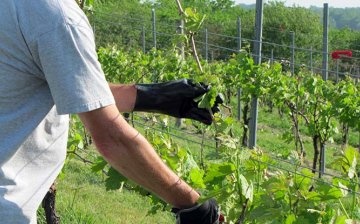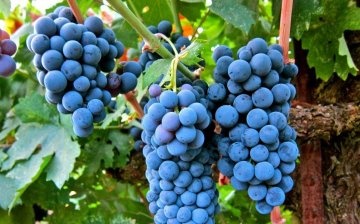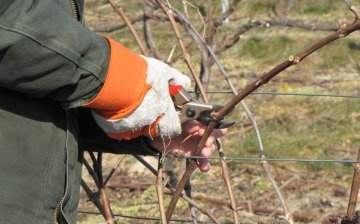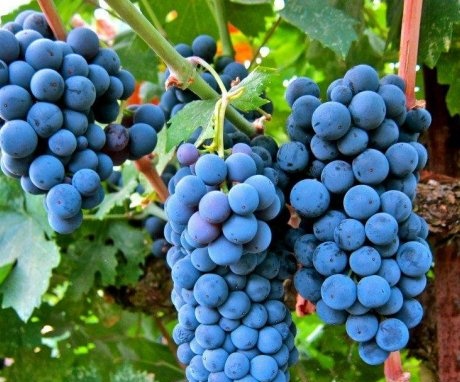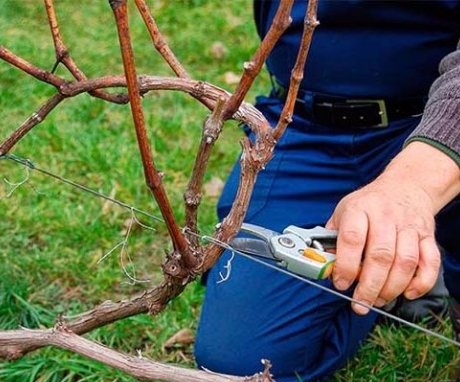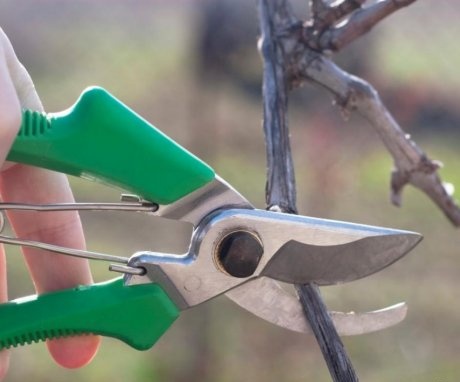Rules, types and scheme for pruning grapes by year
For a high yield grapes it is necessary not only to know about the rules of planting, the conditions for growing vines, but also to understand the role of pruning shoots. Without this procedure, it is impossible to form the bushes so that they have enough nutrition. And it is impossible to collect a large number of sweet berries without taking into account the number of eyes on the shoots.
The technology of growing grapes is quite complex. By annually removing or shortening annual and perennial shoots, the bushes are correctly formed, and stable yields of high quality berries are obtained. Each stage of vine growth is characterized by its own pruning methods.
Content:
- Pruning grapes: value, benefits of the procedure
- Rules, types of pruning
- Pruning in the first and second year of the vine
- The scheme for pruning grapes in the third, fourth and fifth year of the life of the bush
- Rejuvenating grapes with pruning
Pruning grapes: value, benefits of the procedure
The value of pruning stems from biological characteristics grapes:
- The plant lays more buds than the available capacity to produce shoots of the appropriate length from them.
- At the first stages, characterized by the dominance of growth processes, it is necessary to create powerful bushes, to facilitate their entry into the fruiting period.
- After the formation of the skeleton, the plants are engaged in the placement of shoots that bear fruit. For them, a rational size is selected, correctly orienting in space. By changing the load on the branches with the eyes, they start biochemical processes, activate carbohydrate and enzymatic metabolism. This period lasts from three to five years, depending on the selected variety, in what conditions the culture is cultivated.
- After harmonizing the fruiting and growth of grapes, pruning is done in order to regulate these processes, maintain the shape of the bushes, and rejuvenate them. Technological reception during the aging of grapes is important, it activates physiological, biological processes, the fruiting of the plant.
- The advantages of a surgical technique include its positive effect on the lifespan of the vine, the quality of its fruits. Also, thanks to pruning, it is much easier to care for the crop. Grapes grow in favorable conditions, receiving plenty of heat, moisture, nutrients, sunlight.
Without the pruning procedure, the plant will not be able to bear fruit abundantly, it will begin to wither from the thickening of the plantings, lack of nutrition, light, and the appearance of diseases.
Rules, types of pruning
Given the fact that pruning is a surgical technique, it is best done before the start of sap flow. In areas with a warm climate, the period after leaf fall is suitable for the procedure, at an air temperature of at least minus five degrees.
In regions with cold winters, the grapes are pre-pruned to shelter, leaving half of the eyes on the branches.
All that does not form fruit branches are subject to removal. The final procedure is given time in the spring. Old sleeves with poorly developed shoots are cut out. But the growth at the base of the sleeves is left.
The pruning technique is simple and understandable even for a novice gardener. The branches are shortened by cutting two centimeters above the peephole so that the slope is in the opposite direction. Cut so that no hemp remains. The wound should be even, smooth, then it will heal quickly. For the procedure, use sectors, sharp knives, garden saws.
Scientists distinguish four types of removal of a part of fruit shoots:
- Shoots are cut shortly by 1-4 eyes. If the branches at the base of the sleeves are removed in a short way, then the bushes are rejuvenated.
- The cut is of medium length, 5-10 eyes, plays an important role in the formation of the arrows of the fruit branches.
- Pruning is considered long when it is shortened by more than 20 eyes. The combined, or mixed, procedure is carried out with the removal of the lower shoot of the sleeve in a short way, and the upper one - long or medium. This combination is important for creating a fruit link.
Cutting shoots to different lengths is necessary for better placement in space, improving plant productivity.
Pruning in the first and second year of the vine
After planting a one-year-old seedling, two buds are left above the soil level. Before leaving for the winter, they are huddled, covered with a layer of earth of eight centimeters. After removing the winter shelter from the vine in the spring, two shoots are obtained. They will become the main ones. They are tied to stakes.
The importance of pruning in the first two years is to form the bush and prepare it for fruiting.
The stepsons formed on the main branches during the growing season are pinched over the second or third leaf. And shoots that grow out of the ground break out. In the last days of summer, the tops of the main skeleton must be pinched. And in the second decade of October, the entire unripe part of the bush is removed.
As soon as the snow melts, after removing the tire, the biennial plant is dried well and cut off. During the procedure, two buds are left at the main branches. The grown shoots are then tied up. For better development of the grapes, young shoots are harvested in the fall, and the side stepsons are pinched.
The scheme for pruning grapes in the third, fourth and fifth year of the life of the bush
On the four vines available in the grapes in the spring, two developed buds are left, the rest are plucked out. Two shoots grow on four sleeves by autumn. During the summer, they continue to break out branches from the replacement buds, dormant, underground trunk. In the middle of autumn, the unripe part of the bush is removed.
The spring of the fourth year of life is significant, since the formation of two vines on each arm begins. On one arrow, up to 8-12 buds remain, on the replacement shoot - 2 or 3. It will replace the fruiting arrow for the next year, since it will be completely cut out in the fall.
At the onset of the fifth spring, buds are left on two grown shoots: on the first - from 8 to 12, on the second - 2-3. The previous operation is being repeated over the next years. In this case, the arrow is in a horizontal position, and the replacement shoot is placed vertically.
Those branches that form on the arrows can be fruiting and vegetative.
The latter are broken out, leaving half of the total on the arrow. On fruiting branches, it is necessary to pinch the top as soon as the flowers bloom. Such techniques will help provide nutrition to the bunches. During the ripening period, the leaves shading them are cut off, and the stepsons are removed.
When pruning, it is necessary to ensure that the load on the bush is no more than 40-50 buds. Sleeves that live 2-3 years are looking for a replacement from two strong shoots that come from the ground. The techniques carried out for the removal and pruning of shoots contribute to obtaining high-quality fruits, maintaining the shape of the bush.
Rejuvenating the bush with pruning
After 5-7 years of fruiting, the grape plant begins to age. The sleeves are susceptible to this, shoots that begin to be unproductive. The stems, both ground and underground, live the longest in grapes.By pruning the bushes, you can prolong the youthfulness of the bush. This can be done by partial removal of the vine or complete by cutting it off on a black head.
Gradual rejuvenation of grapes is carried out in a fan-like fashion from different sites, which will allow to grow shoots that replace outdated sleeves. If the bush is completely cut off, then the renewal of its skeleton goes through the shoots coming from the roots. And in two or three years a new bush will form.
If the grapes are damaged by frost, diseases, then the cutting of the vine is carried out to living tissues.
After the death of a large number of kidneys, short pruning is performed to awaken the sleeping eyes. Differentiated shortening is carried out in case of damage to the plant by hail, removing the sleeves that are broken, dried out, damaged. Extend fruiting time grapes, to save the bush is the task of the pruning procedure.
More information can be found in the video:



